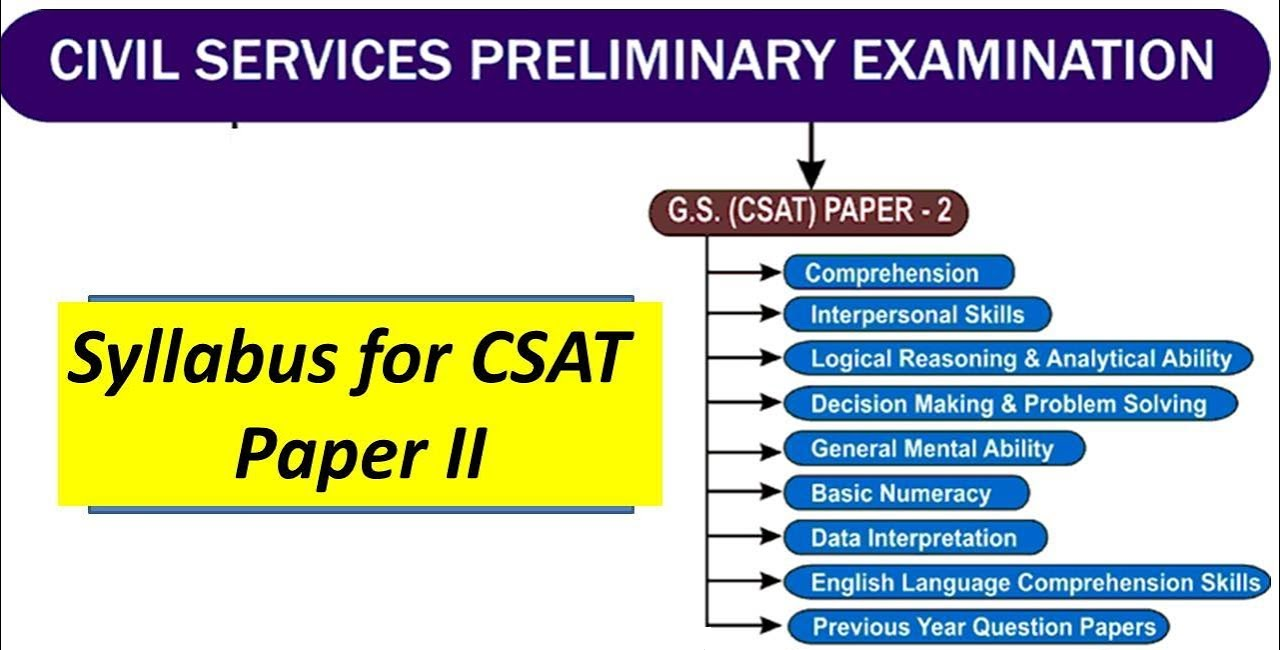
(Getting Started) CSAT – How To Qualify Prelims UPSC PRE GS Paper-2
UPSC tests aspirants on their general awareness and analytical skills. However, before they do that, they want to ensure that the person is truly up to the task by testing their basic communication and aptitude. For this, UPSC has the CSAT Paper-II conducted in the preliminary phase. The paper asks aspirants simple questions on basic arithmetic, analytical, reasoning, and language skills.
Introduced in 2011, until 2015 CSAT was a compulsory paper whose marks contributed to the aspirant’s overall preliminary score. However, starting in 2016, this has become a compulsory paper that is qualifying in nature. Aspirants must score a 33% in CSAT Paper-II for the marks they score in General Studies Paper-I to be considered. In case someone fails to score the required cut-off in CSAT Paper-II, their General Studies Paper-I is not even evaluated.
The CSAT Syllabus
The syllabus for CSAT Paper-II is designed to be an aptitude test. It tests for basic language learning, and some math and reasoning skills as well. All questions are framed at a 10th board standard for that reason. The main components of the syllabus are listed below –
- Comprehension
- Interpersonal skills like communication skills
- Logical reasoning and analytical ability
- Decision-making and problem solving
- General mental ability
- Basic numeracy
- Data interpretation

CSAT Syllabus Analysis
As you can tell, it is quite similar to any basic aptitude level test one has to appear for in any college admission or job-related exams.
How To Approach The Paper
The very first thing to do for CSAT is to pick up any one of the last 5-year question papers for Paper-II for UPSC Civil Services Examination prelims and sit and solve it. At the end of it check your scores. Chances are, you will find yourself effortlessly crossing the qualifying threshold of 66 marks. However, that’s the danger line. Your aim must be to score at least 90-100 in the mock papers. That way, no matter how much pressure you are in during the actual exam, you will be sure to qualify.
Once you have performed this exercise, check which sections are your weakest and which are the strongest. This is known as SWOT(strengths, weaknesses, opportunities, and threats) analysis and allows you to understand where your efforts must go. Now, concentrate on your weakness. Truth be told, a week is enough to get you more than qualifying marks on your CSAT paper if you are smart about it. The SWOT analysis allows you to do smart work as opposed to aimless hard work.
CSAT Preparation Strategy
This should not be difficult at all for a UPSC aspirant. When you read as much text as an average aspirant does in a day, you are already good at reading and noting the important parts of a paragraph. This is another reason why aspirants are advised to read the newspaper daily.
-
Noting Keywords In A Comprehension
Again, this is a piece of cake for a serious aspirant. Anyone who reads the news daily makes notes from the text, will be qualified to do this well.
It might seem that reading the newspaper is all you need to qualify CSAT Paper-II. However, literature is subjective and you can never be a hundred percent sure about whether you will be scored exactly as you imagined you will be. This is where arithmetic and reasoning come to your rescue.
Take your Class 10 math book out. There will be a page somewhere that lists down all the formulas used for solving math problems in the book. Revise them tell you can recall them at the tip of a hat. Believe us when we say this, remembering the right formula at the right time is half the work done.
-
Practice SSC-CGL Quants And Reasoning
There is a bunch of practice questions available for free online for SSC-CGL and similar exams. Pick them up and use them to practice the quantitative aptitude and analytical reasoning question. Try to solve at least 50 questions for each section. You should be good to go.
Once you have done this, you are almost prepared for your CSAT Paper-II. Only one thing is left.
-
Solve Last 5 Years Of UPSC CSE Prelims CSAT Paper-II
|
UPSC CSE Prelims CSAT Paper-II 2018 and 2017 Comparison
|
|
Topic
|
No. Of Questions In 2018
|
No. Of Questions In 2017
|
|
Basic Numeracy And Maths
|
18
|
28
|
|
Reading Comprehension
|
26
|
30
|
|
Logical And Analytical Reasoning
|
16
|
22
|
|
Visual Reasoning
|
6
|
0
|
|
Data Interpretation
|
14
|
0
|
|
Decision Making
|
0
|
0
|
|
TOTAL
|
80
|
80
|
Analysis Of Previous Years’ Question Papers
Use the last 5 years question papers like mock tests. This allows you to get a grasp on your timing so that you can finish your paper on time as well as gives you all the practice mock tests you need. From these tests, you can get the confidence as well to clear the paper in the real exam.
Best Of Luck
For CSAT, remember, you only need to qualify, which means you only need to score 66 marks. Attempting even half the paper with accuracy as low as 75% will give you that. Follow the plan and you will score much more than you could need. We wish you all the very best!
© IASEXAMPORTAL
CLICK HERE TO DOWNLOAD UPSC TOPPERS NOTES